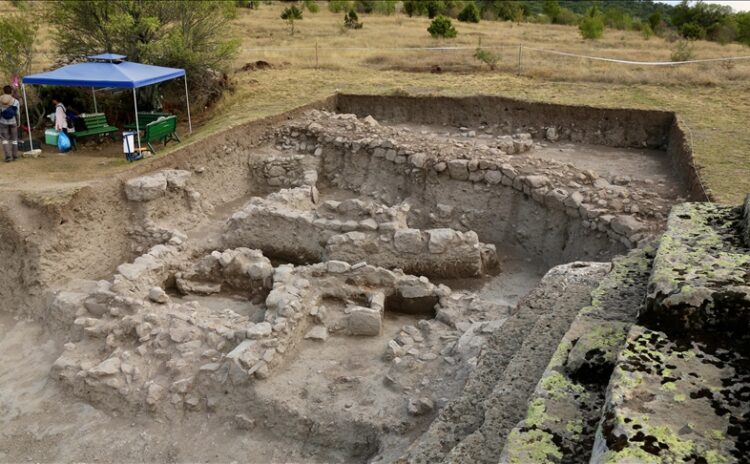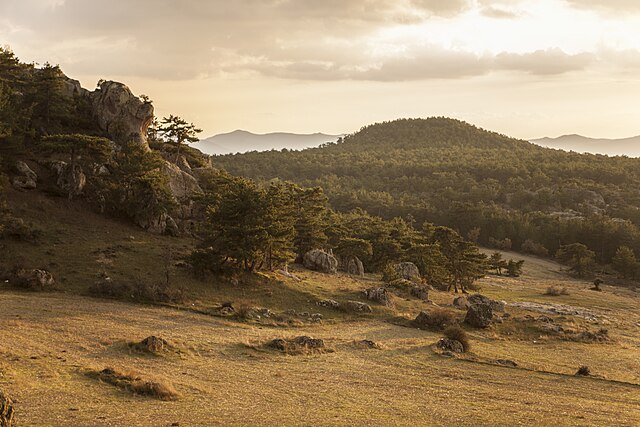ISTANBUL – Archaeologists have made a significant discovery at Midas Castle, an ancient Phrygian site located in Eskisehir, central Türkiye. The recent excavations, led by Dr. Yusuf Polat of Anadolu University, have uncovered artifacts and structures that provide new insights into the religious practices and cultural interactions of the Phrygians, a Bronze Age civilization that once dominated Anatolia. This excavation, which began in 2022, focused on the three-kilometer Midas Valley and revealed relics of Phrygian spiritual life dating back to the seventh century BC.
The Phrygians were an ancient Anatolian people known for their complex religious traditions, and the newly unearthed ovens and hearths suggest that fire played a central role in their rituals. Found near a Phrygian rock altar, these structures are believed to have been used for cooking sacrificial animals and baking bread as part of religious ceremonies. “We identified hearth areas where ritual preparations occurred, marked by simple stone foundations and wooden structures,” Polat explained. Preliminary findings indicate these elements date back to the Middle Phrygian period, roughly the 8th-7th century BC.

The archaeological excavation carried out in Midas Castle in Eskişehir, ovens and stoves belonging to the Phrygians were found. Photo via Anadolu University
Dr. Polat’s team also uncovered evidence that this area, known as the Agdistis Sacred Area, has long been a center of worship. Positioned atop a rocky plateau, this site is part of an 88-acre area that includes the famous Yazilikaya Monument, an open-air temple adorned with rock reliefs of Hittite gods and goddesses. Yazilikaya, near the ancient Hittite capital of Hattusa, has been recognized as a major religious site for centuries. The Hittite carvings include over 90 deities, and it appears the Phrygians integrated some Hittite beliefs into their own, a reflection of the cultural exchanges that characterized ancient Anatolia.
Central to Phrygian worship was Cybele, the Mother Goddess, known as Matar Kubileya, who symbolized fertility, nature, and protection. Her influence extended beyond Phrygia, impacting Greek and Roman religions long after the Phrygians had faded from prominence. Polat noted that, in addition to Cybele, the Phrygians revered a solar deity likely derived from neighboring Anatolian religious traditions. This blending of beliefs underscores the interconnectedness of ancient cultures in the region. Cybele, associated with mountains and the cyclical themes of life, death, and rebirth, would later influence spiritual practices far beyond Anatolia.

Phrygian Valley in Turkey Photo Credit: Andrew Kuznetsov CCA 2.0
The findings at Midas Castle also reveal aspects of Phrygian mystery cults, which were similar to Dionysian rites, focusing on the cycles of life and death. These cults, characterized by ecstatic rituals involving music, dance, and sacrifice, may have also incorporated fire as a symbol of rebirth and transformation. “For the first time, we identified hearths and simple stone foundations in front of a Phrygian altar, indicating fire’s role in ritual preparations,” Polat shared. This discovery supports theories that fire was considered sacred by the Phrygians, likely linked to their worship of Dionysos.
The ongoing excavation at Midas Castle marks the first since 1953 and has yielded not only Phrygian artifacts but also relics from other civilizations, including Roman-era ceramics and tools dating back to the Lower Paleolithic period. “We found Lower Paleolithic stone tools during surface surveys. Almost all subsequent civilizations lived in this geography, as these deep valleys were fertile and suitable for defense,” Polat explained. These findings suggest that the Midas Valley has been inhabited for at least 250,000 years, a testament to its fertile land and strategic position. “Our surface research revealed that almost all subsequent civilizations occupied this geography due to its fertile lands and defensible valleys,” Polat explained.
Another notable discovery was a set of rock basins carved into the bedrock, located near a statue of Matar Kubileya. These basins are believed to have been used in fertility rituals central to Phrygian spirituality. “The presence of the rock bowls and the nearby idol provides concrete evidence of prosperity rituals blessed by the Mother Goddess,” Polat added. Such findings indicate that this area was likely a destination for worshippers from across the Phrygian kingdom, drawn by the promise of Cybele’s blessings.
Dr. Polat and his team also found Lydian ceramics from the 7th-6th century BC and Roman artifacts from the 1st-2nd century, highlighting the area’s historical significance as a crossroad for various cultures. The Phrygian civilization peaked during the Middle Phrygian period, but the region remained a hub of human activity for centuries, even after the Phrygians’ decline following the Cimmerian invasion in 690 BC.
The discoveries at Midas Castle not only deepen our understanding of Phrygian culture but also underscore the region’s role as a nexus of cultural and religious development in Anatolia. The findings reveal how Phrygian beliefs and practices were influenced by, and in turn influenced, surrounding cultures. Dr. Polat’s work illustrates the enduring importance of the Midas Valley, where layers of history continue to offer valuable insights into the ancient world.
As excavations proceed, Polat and his team are likely to uncover further details about the Phrygians and the many civilizations that once called the Midas Valley home. Each artifact contributes to a broader narrative of cultural synthesis and religious evolution, offering a window into the ancient beliefs and practices that shaped this region for millennia.
The Wild Hunt is not responsible for links to external content.
To join a conversation on this post:
Visit our The Wild Hunt subreddit! Point your favorite browser to https://www.reddit.com/r/The_Wild_Hunt_News/, then click “JOIN”. Make sure to click the bell, too, to be notified of new articles posted to our subreddit.
